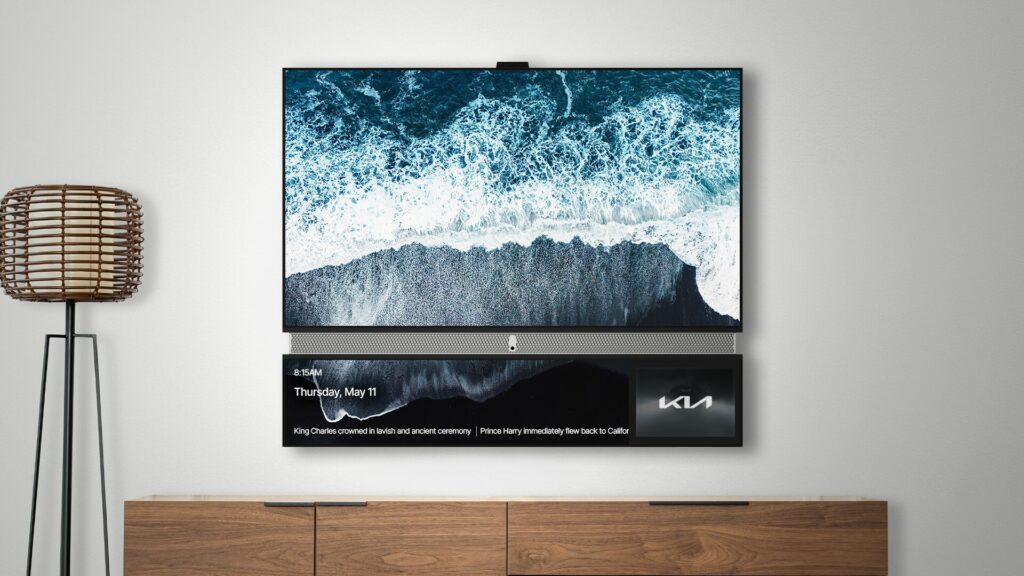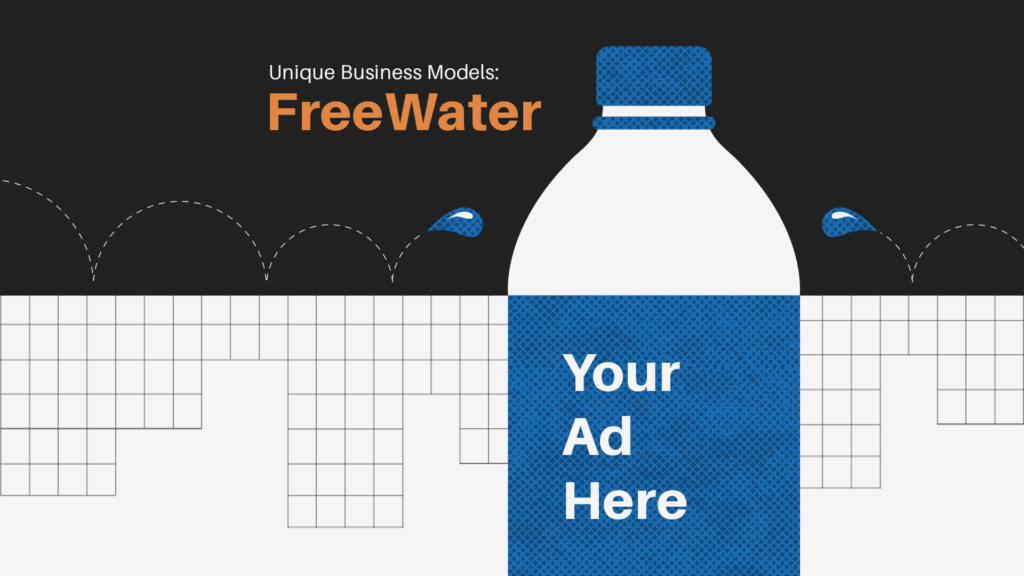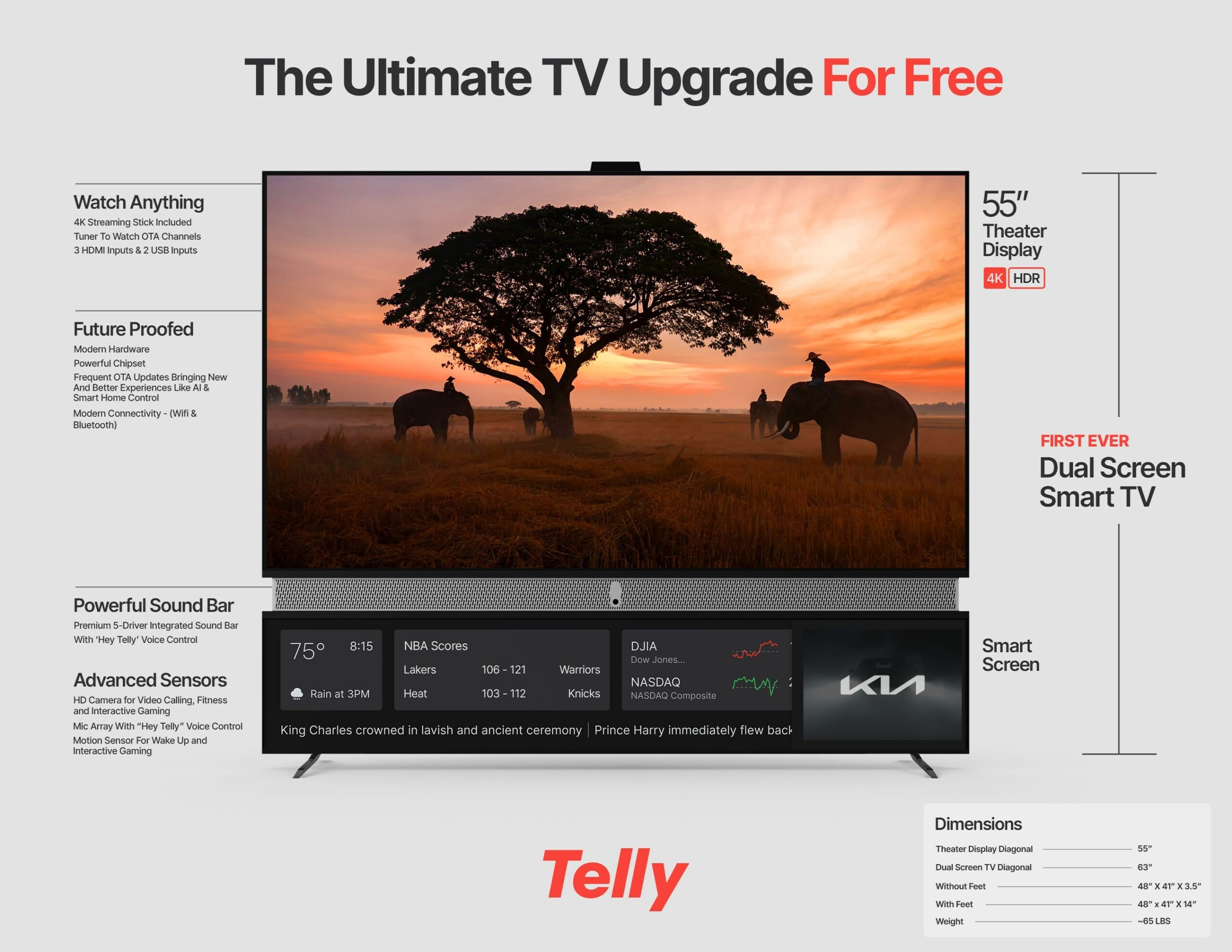Do you want a free telly? Well, now you can get one for free thanks to Telly’s unique business model – assuming you’re in America.
Telly is a California-based startup that is attempting to disrupt the TV industry – but not in the way you think.
No, it didn’t invent any revolutionary new product, nor did it develop any mind-blowing new tech. In fact, its product is similar to the numerous other smart TVs already out on the market that established brands like Samsung, LG, and Sony are selling.
So how exactly is Telly innovating and disrupting the TV industry?
Telly’s Unique Model Of “Selling” Free TVs

Telly’s main difference from traditional brands like Samsung, LG, and Sony is in its unique business model. Innovation, after all, is much more than building new tech.
Unlike those industry stalwarts, Telly doesn’t sell TVs – the startup gives them away for free. According to an article on TechCrunch, the TV set plus an accompanying Android TV dongle costs approximately $1,000.
“Telly is a revolutionary step forward for both consumers and advertisers. For too long, consumers have not been an equal part of the advertising value exchange. Companies are making billions of dollars from ads served on televisions, yet consumers have historically had to pay for both the TV and the content they watch. All of that changes today.” said Telly founder Ilya Pozin in a press release.
Telly’s founder, Ilya Pozin, is the co-founder of free ad-supported streaming platform Pluto TV. Telly and Pluto TV found an opportunity to innovate and create a world where both content and the device used to view the content are free to customers.
“When I co-founded Pluto TV, we created an entirely new model that offered amazing TV content to viewers for free. Now, with Telly, we are providing the actual television for free as well,” added Pozin.
Thus, Telly’s customers don’t have to pay for any upfront costs to get the free Telly TV set. However, customers still “pay” in one crucial non-monetary way that enables Telly’s entire unique business model.
Get the latest innovation news and exclusive event invites direct to your inbox. Subscribe to our newsletter!
How does Telly earn?
To recoup the cost of the television set and make a profit, the Telly TV set displays ads 24 hours a day, 7 days a week on a part of the TV’s smaller secondary screen. It essentially puts an interactive dynamic billboard in the living rooms of each customer’s house.
Thus, advertisers technically foot the approximately $1,000 price tag of the TV set instead of the industry standard where end customers foot the bill.
The cost to end-customers, however, is signing over data to Telly and advertisers.
Presumably, to tailor-fit each ad to the consumers using the TV, Telly collects data about its users. According to a report by Variety, Telly collects data including personal information, viewing habits, purchasing behavior, and brand preferences. Customers need to agree to Telly using their information for targeted ads.
The same report also states that the free TV set is capable of identifying how many people are in front of the screen although it is not clear if the company collects this information.
This new way of doing business and “selling” TVs could make the business models of traditional retail brands expire and be replaced by this innovative ad-supported model.
What Other Companies Have A Similar Unique Business Model?

Besides Telly and Pluto TV, other businesses have similar ad-supported business models – one of the most prominent of which is Texas-based beverage company FreeWater.
FreeWater’s business model revolves around giving away free eco-friendly cartons or metal bottles of water to customers in high-traffic areas. Just like Telly, FreeWater’s product has no upfront cost for the consumer.
Who then pays for the water? Advertisers.
The startup prints advertisements on the packaging of each carton or bottle of water, essentially putting a free billboard in everyone’s hands. It’s just like how Telly puts a free billboard in everyone’s living room.
“Basically, we transform product packaging into ad space. Those ads cover the cost of the product’s manufacturing, distribution, the salesperson’s commission, donation to charity, and our profit. The product is then free for the consumer,” said FreeWater founder Josh Cliffords in an interview with Austin Monthly.
Thus, this ad-supported revenue model seems to be taking off even beyond the realm of media where the likes of YouTube, Facebook, and Pluto TV pioneered it. And just because the products are free doesn’t mean theyre any less quality than their mainstream competitors.
What Is Included In The Free Telly TV?

Its offering matches and may even surpass some of the higher-end smart TVs on the market that are sold by established brands – with numerous integrated features, and futureproofed quality hardware.
Features Of The Free Telly TV
- Dual-screen smart TV
- 55-inch 4K HDR main screen
- Integrated second smart screen
- Built-in 6-driver immersive Harman Kardon soundbar
- More than 40 video games
- In-built camera with privacy shutter & microphone
- Integrated Zoom video calling
- Music and video streaming
One key hardware difference from other TVs is its integrated second smart screen. Telly says it’s the first to offer a two-screen smart TV. Besides showing ads, the smaller secondary screen also displays other useful information like weather data, sports game results, stock market performance, and a news ticker.
Furthermore, the ads themselves are innovative as they are interactive. Telly’s founder said in an interview that for example, you can order a Pizza Hut pizza directly from the TV set if a customer clicks on the ad using the remote.
Another unique feature of the TV set is the Telly Game Room which features over 40 video games that customers can play alone or collaboratively with their family and friends. According to Telly, these video games include arcade classics and immersive multiplayer games that users can control with the TV remote or their body.
It also has premium hardware like a Harman Kardon branded soundbar, a 4K HDR main screen, and an in-built camera with a privacy shutter.
Get the latest innovation news and exclusive event invites direct to your inbox. Subscribe to our newsletter!
How Do I Get A Free TV From Telly?
Who wouldn’t want a free TV right? There are only a few steps interested customers need to take to reserve and take delivery of their free TV.
First, customers need to sign up on their website and give their name, address, and phone number. Then, customers are asked to download the Telly app on their mobile phone and sign up for an account.
They’ll then complete a survey where presumably the aforementioned data, including viewing habits, purchasing behavior, and brand preferences will come in.
By doing all of this, Telly and its advertisers will shoulder the cost of the TV set as well as delivery.
Interested customers will have to act fast though as Telly is only delivering 500,000 units of its TV for the first round of reservations – of which 250,000 customers already reserved units in the first two weeks of its launch.
In a TechCrunch interview with Telly’s founder, Pozin revealed that the majority of its registered customers fall within the Gen Z and Millenial generations – the two that are the most difficult to track in terms of advertising as they are the most averse to using ad-supported services.
Go On A Deep Dive Into Innovative Business Models With Embiggen
There are plenty more innovations out there, from Netflix’s revolutionary subscription-based pricing model that disrupted the traditional media rental industry to GCash’s innovative way of enabling digital payments and e-wallets in a country with a large unbanked population.
Explore all of these and more with the Embiggen Innovation Institute’s innovation capability development programs.
The Embiggen Innovation Insitute (EII) is the Embiggen Group’s innovation learning arm that is making world-class innovation education and capability development programs more accessible to Filipinos.
It is the go-to firm of top organizations in the Southeast Asian region for their corporate innovation strategy development and capability-building initiatives. EII and its team have built the innovation capability of over 20 organizations and have trained over 1,000 innovators in innovation and innovation management.
It is the exclusive certified training partner in the Philippines of the Global Innovation Management Institute (GIMI), the worldwide innovation standard certification board based in Cambridge, Massachusetts, U.S.A. GIMI has trained over 10,000 innovators including those from Fortune 500 companies.
Learn more about the work that EII does here.

